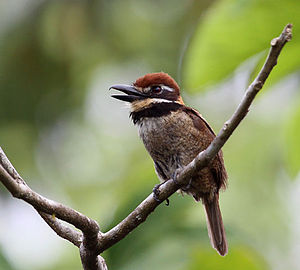Long toe lazy bird
| Long toe lazy bird | ||||||||||
|---|---|---|---|---|---|---|---|---|---|---|

Long-toed sluggard ( Cyphos macrodactylus ) |
||||||||||
| Systematics | ||||||||||
|
||||||||||
| Scientific name of the genus | ||||||||||
| Cyphos | ||||||||||
| Spix , 1824 | ||||||||||
| Scientific name of the species | ||||||||||
| Cyphos macrodactylus | ||||||||||
| Spix, 1824 |
The long-toed lazy bird ( Cyphos macrodactylus , syn .: Bucco macrodactylus ), also known as the brown-capped lazy bird , belongs to the family of lazy birds within the order of the woodpecker birds .
features
The long-toed lazy bird has a compact build with a large head and a very short neck. Its tail is slightly forked and its wings are relatively wide. The feet are short and dark gray, the toes are arranged in pairs. The bird's strong gray beak is short and ends in a hook, with a few bristles at the base of the beak. The large eyes with their red irises stand out from the rather brownish plumage. They are surrounded by a dark gray, featherless eye ring. The head has two black bands. The first is below the eye, the second is on the chin. Above the eye and between the ligaments the plumage is beige to white, towards the beak it turns orange. The bird has a brown skull that extends to the yellow-brown neck. The beige underside has many gray zigzag bands that are close together. These are more indistinct on the wings. The tail is light brown. The long toe lazy bird reaches a body length of about 14 centimeters.
Way of life
The long-toed lazy bird is a loner . However, in the breeding season it occurs in pairs. He is sitting in a low control room, searching the ground for insects . Then it pounces on its victim, lands, takes it in its beak and flies back to its control room.
The female lays two to three white eggs in the den of tree termites or in a self-dug cave on the ground or on an embankment. The entrance to the nesting site is often camouflaged with leaves and twigs.
Habitat and Distribution
The long-toed lazy bird lives in sparse forests, on the edges of forests and in the tree savannas of South America. It occurs in western Brazil , Bolivia , Peru , Ecuador , Colombia and Venezuela . It can often be found near water. According to the IUCN , the species is ![]() (= least concern - not endangered).
(= least concern - not endangered).
Subspecies
The demarcation of the population from the south of Venezuela in the area of the Río Caura as a separate subspecies Cyphos macrodactylus caurensis ( Cherrie , 1916) is controversial.
Research history
Johann Baptist von Spix undertook a research trip to Brazil on behalf of King Maximilian I of Bavaria between 1817 and 1820 . Together with the botanist Carl Friedrich Philipp von Martius , he traveled to the Amazon basin as a zoologist and was the first to bring many prepared specimens of unknown animal species from this area to Europe, including a number of bird skins , which he described in two volumes in 1824 and 1825, including Cyphos macrodactylus . Spix died in 1826, presumably of a tropical disease. His type specimens are kept in the Zoological State Collection in Munich . In 1827 his assistant and successor Johann Georg Wagler described the long-toed sluggard again under the name of Capito cyphos . In 1863, Jean Louis Cabanis and Ferdinand Heine senior put the sluggard as Argicus macrodactylus in a separate, monotypical genus. In 1906, the birds that Spix described only superficially because of his illness were revised by Carl Eduard Hellmayr . The long toe lazy bird was placed as Bucco macrodactylus in the genus Bucco . Depending on the opinion of the authors, the long-toed lazy bird was henceforth separated from the other genera as Argicus macrodactylus , or placed as Bucco macrodactylus in the genus Bucco , which is considered the "archetype" of the Bucconidae. According to today's view, the differences to the other lazy birds, including the short and compact beak of the long-toed lazy bird, are decisive for placing it in its own genus. This was given the name Cyphos originally proposed by Spix .
Individual evidence
- ↑ Cyphos macrodactylus in the Red List of Threatened Species of the IUCN 2013.2. Listed by: BirdLife International, 2012. Retrieved February 6, 2014.
- ↑ a b PC Rasmussen, N. Collar & Guy M. Kirwan: Chestnut-capped Puffbird (Cyphos macrodactylus) . In: J. del Hoyo, A. Elliott, J. Sargatal, DA Christie & E. de Juana (eds.): (2013). Handbook of the Birds of the World Alive. Lynx Edicions, Barcelona 2013 (accessed January 13, 2015)
- Jump up ↑ Johann Baptist von Spix: Avium species novae, quas in itinere per Brasiliam annis 1817-1820 jussu et auspiciis Maximiliani Josefi I. Bavariae regis succepto collegit et descripsit Dr. JB de Spix . 1st volume, Munich 1824 first description
- ^ Carl Eduard Hellmayr : Revision of the Spix's types of Brazilian birds. Treatises of the II. Class of the Royal Bavarian Academy of Sciences, XIII, III. Dept., 1906
- ^ Jean Louis Cabanis: Directory of the ornithological collection of the Oberamtmann Ferdinand Heine, on Gut St. Burchard before Halberstadt. Museum Heineanum, 4, 1, Halberstadt 1863, p. 148
literature
- Johann Baptist von Spix : Avium species novae, quas in itinere per Brasiliam annis 1817-1820 jussu et auspiciis Maximiliani Josefi I. Bavariae regis succepto collegit et descripsit Dr. JB de Spix . 1. Volume, Munich 1824 (first description)
- Colin Harrison and Alan Greensmith: Birds . Dorling Kindersley Limited, London 1993 ISBN 3-473-46076-1
Web links
- Avibase
- Birdlife international
- Cyphos macrodactylus in the Red List of Threatened Species of the IUCN 2013.2. Listed by: BirdLife International, 2012. Retrieved February 6, 2014.